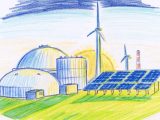
Methane Splitting Technology Approved by DNV for Onboard Hydrogen Production
November 20, 2025DNV has handed out an Approval in Principle (AIP) to Hycamite TCD Technologies’ onboard methane splitting system for LNG-powered vessels. After months of rigorous tech checks and safety deep-dives, this marks the first-ever green light for a pre-combustion carbon capture approach in shipping—finally taking onboard hydrogen production out of the lab and onto real ships.
The drive towards maritime decarbonization has never been hotter. The IMO is aiming to slash greenhouse gases in half by 2050, and Europe’s Fit for 55 rules are ratcheting down emissions even faster. Sure, fuels like ammonia, methanol or liquid hydrogen get tossed around as alternatives, but each one brings headaches—be it tricky storage, hefty bills or shaky supply chains. That’s where methane splitting comes in, letting operators stick with mature LNG bunkering while cranking out near-zero-emission hydrogen onboard.
Could this be the answer to shipping’s carbon problem?
Here’s the thing: most LNG ships still burn methane, pumping out CO₂ and that sneaky “methane slip.” Meanwhile, steam methane reforming onshore racks up 9–20 kg CO₂e to produce every kilo of H₂, and electrolyzers demand mountains of renewable power. With Hycamite’s thermocatalytic decomposition (TCD), CH₄ is split into two gold stars—hydrogen and solid carbon—while locking in emissions before they ever see daylight. The result? Under 1 kg CO₂e per kg H₂ on deck.
At the center of it all is Kokkola, a tight-knit Finnish city tossing its weight around in heavy industry. Home to Hycamite’s customer sample facility (CSF), one of Europe’s biggest TCD plants, Kokkola benefits from Finland’s forward-thinking climate policies, a buzzing research scene and a knack for spinning deep-tech ideas into commercial gold.
How the TCD process delivers hydrogen and solid carbon
Think of it like this: methane from the ship’s LNG tanks enters a sealed reactor warmed to 800–1000 °C. Inside, a proprietary catalyst gets to work, cleaving CH₄ into two handy products:
- Hydrogen gas – piped straight to fuel cells or dual-fuel engines, offering high power density and nary a whiff of CO₂ on exhaust.
- Solid carbon – captured in onboard bins at room temperature, then offloaded at port and sold off as graphite or specialty carbon materials.
No oxygen means no CO₂ slip, and the whole setup needs about 87% less energy than electrolyzers. It’s efficiency and maritime decarbonization rolled into one slick package.
Best part? The TCD module is built to integrate with existing LNG fuel systems—think Wärtsilä’s LNGPac. That means minimal design tweaks, shorter dock times and an easier retrofit path for both old hulls and new builds. Capital outlay stays in check, letting shipowners hit the water faster.
Safety and certification on the high seas
Playing with hydrogen at sea demands bulletproof safety. Hycamite’s setup features double-walled reactors, automated pressure relief valves and nonstop process monitoring. The reactor’s oxygen-free zone keeps flammables at bay, and DNV’s exhaustive risk assessment gave it a seal of approval. With this DNV Approval in the logbook, Hycamite is gearing up for type approval and full-class certification—opening the door to commercial rollouts worldwide.
Who’s steering the ship?
Hycamite TCD Technologies sprang from Finland’s top research institutes, amassing a suite of patents around methane splitting. Their Kokkola CSF proves continuous, reliable hydrogen and carbon output at scale. On the flip side, DNV—the venerable Norwegian classification society—brings a century of maritime safety expertise, assessing risk, ensuring compliance and fast-tracking innovative tech through its AIP process.
Why operators should be excited
Shipowners and operators stand to gain big time:
- Immediate emissions cuts – onboard hydrogen production emits zero CO₂ at point of use, helping you hit IMO and EU targets.
- Competitive costs – producing H₂ on deck for roughly $2–3/kg using stranded LNG feedstock undercuts delivered liquid hydrogen prices.
- Additional revenue – turn the solid carbon byproduct into cash by selling to battery, steel or composite makers.
- Compliance and credits – pre-combustion carbon capture aligns with emerging carbon markets, unlocking tradable credits.
- Negative carbon potential – swap in biomethane feedstock and you lock away CO₂, making your vessel a floating carbon sink.
- Retrofit-ready design – modular units slot into a range of ship types, from small chemical tankers to giant container vessels.
Looking ahead, Hycamite plans to roll out over 50 shipboard modules by 2030. Partnerships with major engine builders and leading shipyards mean the first retrofits could hit the water in as little as two years—exactly the pace maritime decarbonization needs.
What could this mean for global shipping?
Imagine a container vessel crossing the Pacific, generating its own hydrogen each voyage, then offloading its solid carbon byproduct at port as a valuable commodity. A fleet-wide rollout could eliminate millions of tonnes of CO₂ from maritime operations annually. Ports would transform from simple bunkering stops into vibrant carbon-material trading hubs—linking seaborne trade directly to onshore decarbonization efforts.
Setting sail towards a greener future
This DNV Approval in Principle isn’t just a technical nod—it’s a signal that pre-combustion carbon capture via methane splitting has matured. With LNG bunkering networks already sprawled across key trade routes, operators can start onboard hydrogen production without waiting on specialized infrastructure. As IMO regulations tighten and shipowners hunt for cost-effective decarbonization routes, Hycamite’s solution is poised to become the standard for next-generation propulsion.
So, what’s next? Keep your eyes peeled for those first Hycamite retrofits and purpose-built newbuilds. If they deliver on their promise, we’ll likely see a wave of cleaner vessels charting greener courses—proof that the voyage to net-zero shipping is already underway.


 With over 15 years of reporting hydrogen news, we are your premier source for the latest updates and insights in hydrogen and renewable energy.
With over 15 years of reporting hydrogen news, we are your premier source for the latest updates and insights in hydrogen and renewable energy.